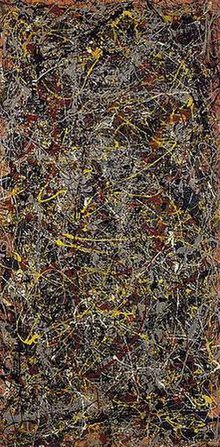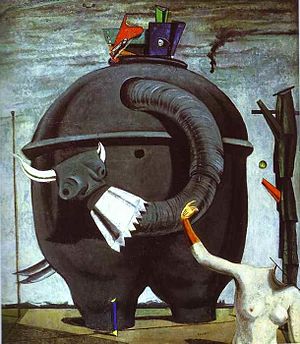Abstract Expressionism is a landmark in the general history of art and of modern art in particular. It has been used during the 1920s.Like the Cubist epoch it represents a revolutionary event which revises our view of things before and after.
The term was introduced by critic Robert Coates in an article in 1946 about the work of Gorky, Pollock and De Kooning though it was only one of many terms of art which might confront an irrational absurd world.
The movement's name is derived from the combination of the emotional intensity and self-denial of the German Expressionists with the anti-figurative aesthetic of the European abstract schools such as Futurism, the Bauhaus and Synthetic Cubism. Additionally, it has an image of being rebellious, anarchic, highly idiosyncratic and, some feel, nihilistic.
Hans Hoffmann who had gained firsthand experience of the European avant-garde befroe opening his school in 1934, taught his visual experiences to others. hewas joined by other European artists seeking refuge during World War II, notably the Surrealists Andre Breton, Andre Masson, Roberto Matta, Yves Tanguy and Max Ernst.
Abstract Expressionism received international recognition after the MoMA's 1958-59 travelling exhibition, "The New American Painting" which toured 8 European countries. By this time, however not only wasthe work no longer particularly new.
 Jackson Pollock, No. 5, 1948,
Jackson Pollock, No. 5, 1948,
 Jane Frank (1918-1986): Crags and Crevices, 1961
Jane Frank (1918-1986): Crags and Crevices, 1961
 Hans Hofmann The Gate,
Hans Hofmann The Gate,
*Anfom, David, Abstract Expressionism, 1990, Thames and Hudson
*Dempsey Amy, Art in the Modern Era, Harry N. Abrams Inc.,2002
 Morris Louis, Where
Morris Louis, Where
 Shaped Canvas, Frank Stella 1967
Shaped Canvas, Frank Stella 1967 Ellsworth Kelly, The Meschers, 1951
Ellsworth Kelly, The Meschers, 1951 Morris Louis, Where
Morris Louis, Where
 Shaped Canvas, Frank Stella 1967
Shaped Canvas, Frank Stella 1967 Ellsworth Kelly, The Meschers, 1951
Ellsworth Kelly, The Meschers, 1951 Jackson Pollock, No. 5, 1948,
Jackson Pollock, No. 5, 1948,
 Jane Frank (1918-1986): Crags and Crevices, 1961
Jane Frank (1918-1986): Crags and Crevices, 1961
 Hans Hofmann The Gate,
Hans Hofmann The Gate,
 Salvador Dali
Salvador Dali Max Ernst, The Elephant Celebes (1921)
Max Ernst, The Elephant Celebes (1921) A Night at Saint Jean-de- Luz (1929)-Man Ray
A Night at Saint Jean-de- Luz (1929)-Man Ray The Red Tower (1913)
The Red Tower (1913) Love Song 1914
Love Song 1914 
 Mario Sironi "Periferia" 1922
Mario Sironi "Periferia" 1922 Giorgio De Chirico - Incertezza del poeta 1913
Giorgio De Chirico - Incertezza del poeta 1913